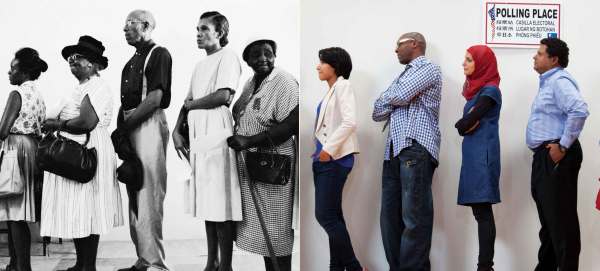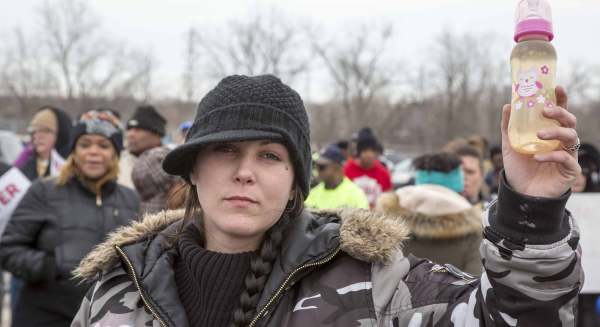
Each week, the Ford Foundation offers a social justice recap of the latest episode of America Divided—a docu-series about rising inequality in the United States. You can watch America Divided on Friday nights at 9 pm EST on EPIX.
In tonight’s episode, we revisit two stories from last week’s premiere: Norman Lear’s investigation of New York City’s affordable housing problem and Rosario Dawson’s uncovering of the democratic failures that caused the Flint water crisis. This week, viewers are introduced to another serious manifestation of America’s inequality problem: the growing opportunity gap between black and white students.
Racial segregation and discrimination in housing
Racial segregation is a major theme in tonight’s episode. Norman Lear observes that people of color seem to be hurt most by a lack of quality affordable housing, and are pushed into unlivable homes in struggling neighborhoods.
Lear speaks with New York Times reporter Nikole Hannah-Jones, an expert on racial segregation, who explains that America’s long history of housing discrimination still perpetuates the income and opportunity gaps between black and white neighborhoods today. She explains that in the 1930s, in response to the Great Depression, the federal government initiated a housing program to insure federal loans to homebuyers—with the goal of building the middle class.
But by giving white neighborhoods the best ratings for mortgages, racially integrated neighborhoods a lower rating, and black neighborhoods the worst rating, the program explicitly institutionalized racial segregation in housing. In fact, the government implemented a policy of “redlining” that used a red line on a map to mark up black neighborhoods where it refused financial investment. As a result, 98 percent of the federally backed loans went to white Americans.
The legacy of this racial discrimination continues today, and the episode provides a powerful illustration of it. To see if a landlord will discriminate against potential tenants based on race—a practice that is illegal—Norman Lear and African American actor L. B. Williams each go undercover with hidden cameras. The outcome is unsettling: The landlord tells Williams there are no available apartments, but 12 hours later tells Lear that several units are available (see video).
Accessibility Statement
- All videos produced by the Ford Foundation since 2020 include captions and downloadable transcripts. For videos where visuals require additional understanding, we offer audio-described versions.
- We are continuing to make videos produced prior to 2020 accessible.
- Videos from third-party sources (those not produced by the Ford Foundation) may not have captions, accessible transcripts, or audio descriptions.
- To improve accessibility beyond our site, we’ve created a free video accessibility WordPress plug-in.
Rampant housing discrimination continues to exacerbate racial inequality and segregation today. In Evicted: Poverty and Profit in the American City, Harvard sociologist Matthew Desmond (a Ford grantee) finds that African American families generally look for housing in neighborhoods on the edges of a city, which are usually predominantly white or Hispanic. It’s only after being rejected for housing in those places that they end up in inner-city neighborhoods.
The resegregation of the US education system
Deeply connected to housing discrimination, the problem of racial segregation affects many school systems across the United States.
In tonight’s episode, we are introduced to actor Jesse Williams as he explores America’s history of school segregation, and the consequences still playing out in the lives of African American students today. Williams visits the wealthy city of St. Petersburg, Florida, which has become the unlikely epicenter of a growing educational divide between white and black kids.
Talking to civil rights and education experts, Williams discovers how the legacy of housing discrimination packed much of the city’s black minority into poorer neighborhoods in the south. In the 1970s, school busing programs were instrumental in desegregating and integrating schools in St. Petersburg and across the country; from 1970 to the late 1980s, the achievement gap between white and black students was cut in half.
But starting in the early 1990s, many school desegregation efforts declined despite their proven effectiveness. In St. Petersburg in 2007, the county school board ended the school busing program in an effort to cut costs. After almost a decade, schools in the city have become increasingly segregated. As a result, the majority-white schools in the city’s affluent neighborhoods rank among the top schools in the state, while five schools in St. Petersburg’s predominantly black neighborhood are the most underperforming. In these five schools, 95 percent of black students are failing reading, writing, or math.
Discrimination in housing and education are not only intricately linked to each other but also linked to voter discrimination. We’ve written about how efforts to advance education and voting rights are fundamental to creating opportunity. Yet recently there have been systematic attempts to undermine both.
Trying to move forward in Flint
Finally in tonight’s episode, we return to Flint, Michigan, with Rosario Dawson. The poisoning of the city’s water system has gotten national attention, including a visit from the president. Unfortunately, as Dawson points out, not even the president’s visit can make the water in Flint safe. And even though Flint switched its water source back to a safer supply—the Detroit River—months ago, the water is still flowing through corroded lead pipes.
To truly fix the problem, much of Flint’s water infrastructure needs to be overhauled, which will require a lot of money and possibly many years of investment. While much of this money will need to come from the local, state, and federal government, philanthropy also has an important role to play in investing in the future of Flint and its citizens. Ten foundations, including Ford, have partnered to commit $125 million to help Flint and its residents recover from the water crisis. The money will go to providing safe drinking water, meeting local health needs, promoting community engagement, supporting early education, and revitalizing the economy.
But even after the water is safe to drink, Flint will be left with the same political system that helped create the crisis in the first place. The system of unelected and unaccountable emergency managers running the city will continue to reinforce inequalities that shape the lives of Flint’s residents. So beyond addressing immediate problems with the water, the city needs investment in efforts to redesign governance institutions to make them more responsive and accountable, and to empower the voices and rights of the city’s citizens.




